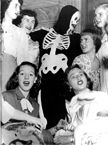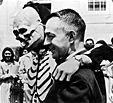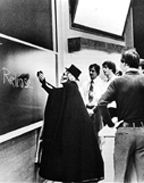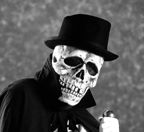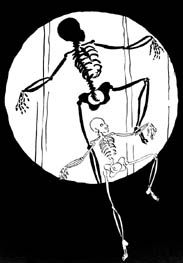|
|
||||||||||
|
Volume
75 Enigma: The Haunting of Uppergate House Wonderful
Woodruffs
From his perch in the Science Room, where he hangs with a steel rod up his back to support him, Dooley has been able to observe and note the characteristics of every member of the College community.
Dooley
has made
|
It may be easier to describe the endearing aspects of Dooley because the history is somewhat clear, the traditional enactments fairly routine, and the cant easily adaptable. What is known is that in October 1899, the Phoenix, Emory’s monthly literary journal of the day, carried—amid articles on the evolution of penmanship, the poetry of Sidney Lanier, and the Civil War prison at Andersonville—an essay titled “Reflections of the Skeleton.” Purporting to be from a specimen in the Science Room, the essay began with a lament of students’ return to campus: “For three months I have had a rest up here among these silent specimens, pickled bull-frogs, canned quadrupeds and other reptilian vertebrates, but now these college boys are back again and I am miserable.” We learn certain facts about the skeleton in this self-introduction (he used to live in New York, for instance), but more interestingly we can infer something of his character. Ruminative (what else can he do, after all?), somewhat dour, he remarks that he is unsure whether he is doing any good in the world, “because there is no element of love or work in my life.” Presumably he once loved being alive, but he notes that times have changed; sophomores now disturb the silence by singing “Hello, My Baby.” He laments, “I am real glad I am dead, since people have begun to sing such songs.” Then we hear no more from the skeleton until 1909. In the October issue of the Phoenix that year appears “Dooley’s Letter—By Way of Introduction.” Somewhat at odds with the earlier bone-man, this letter writer distances himself from “that spurious Mr. Dooley who lives and writes in New York. I am the only original, authentic, and genuine Dooley.” He reflects on his life as the only son of a wealthy Virginia planter. Born during the Revolutionary War, he retired to Georgia after a long and eventful life. “Bearing the scars of many battles,” Dooley visited Emory College and has kept up with its history. “I little dreamed then that my lot later in my experience would be cast with her as a member of her faculty.” Reaching old age and finding his strength of mind declining, Dooley was seized by “an old habit which I learned while campaigning”—drinking alcohol. Soon “liquor ruined me,” and Dooley passed from this life “in the home for incurables”; the home’s doctor saved the skeleton for instruction and eventually found Dooley “this position on the faculty at Emory.” From his perch in the Science Room, where he hangs with a steel rod up his back to support him, Dooley has been able to observe and note the characteristics of every member of the College community. In the 1909 letter Dooley relates in great detail his first—and so far only—visit to the chapel, when unidentified boys “in the early hours of a dark and gloomy night” carried him from the Science Room to the chapel, where they suspended him from the ceiling above the president’s chair on the rostrum.
Lighting into the assembled body for the frivolity at hand, President Dickey vented rage at the sacrilege of the skeleton’s presence in chapel. Dooley himself felt defended, at first, but then soon realized that he himself was the object of Dickey’s rant.
No doubt that sentiment regarding chapel spoke for many of “the boys.” Wishing he had more space for more such stories, Dooley promises to contribute regularly to the Phoenix. Before signing off, however, he utters his immortal parting line: “Presidents may come and presidents may go; professors may come and professors may go; students may come and students may go; but Dooley goes on forever.” An invisible but vociferous commentator on College life in the last years of Emory’s Oxford existence and the first years in Atlanta, Dooley published his observations in the Phoenix and, later, the yearbook the Campus while managing to maintain the anonymity of his amanuenses. Not until 1941, apparently, did Dooley begin his campus appearances as a kind of Lord of Misrule. That year the trustees at long last permitted dancing on campus, and student activities coordinators planned a “frolic” to take advantage of the new freedom. Lending his name to the romp, Dooley himself appeared at “Dooley’s Frolics,” a tradition that persists to this day as “Dooley’s Week.” In the ensuing decades a number of other traditions have grown up around the figure of Dooley. Contriving to appear on campus at the beginning of the week that bears his name, Dooley has made his entrance by every means imaginable—one year coming through the Haygood-Hopkins Gate on a motorcycle, another year landing in a helicopter on the Quadrangle, and still another time rising from his very grave on the Quad. Custom has allowed him the privilege to arrive at a classroom and set students free. His “peacekeeper” is a squirt gun. Since an unpleasant incident in the impudent sixties, when a student attacked Dooley with the apparent intention of unmasking him, the visitor from Beyond is accompanied by a retinue of hand-picked students, whose black garb and “shades” appropriately complement the weird visitor from the grave. Taking for himself the first name and middle initial of whoever happens to be the University’s president, Dooley rises above the mutability of University life and, indeed, of life itself. Which brings up the more excruciating aspect of Dooley. There was the moment preceding the Carter Town Hall Meeting in September 1996, when Dooley came to the Woodruff Physical Education Center to pay his respects to President Jimmy Carter and the gathered freshman class. Those who were there still recount the interminably long, painfully slow walk Dooley made from the back of the audience to the stage, and then, having had his statement read, the equally patience-wearing crawl back out the doors. How is it that such a spirit of irony—at times whimsical, at times caustic—with enough of a penchant for physical courage to ride motorcycles and helicopters (what has he got to lose, after all?) can have become the decrepit and unimaginative traveler of the 1990s? Does it have something to do with the decade—the infection of bones by a widespread American caution inspired by economic prosperity and anxiety about its end? Fear that the new millennium will bring the sound of Gideon’s trumpet, raising others long-dead from their graves too? Who knows? But surely one can hope that Emory’s Lord of Misrule, who once had the flexibility to clamber out of a coffin and the vitality to scamper in and out of classrooms, can learn once again to move with the speed of laughter.
|
||||

